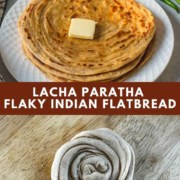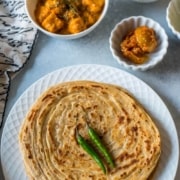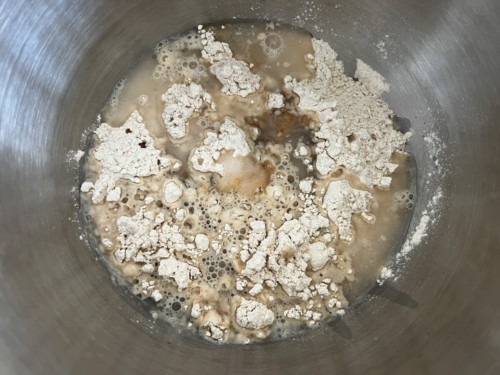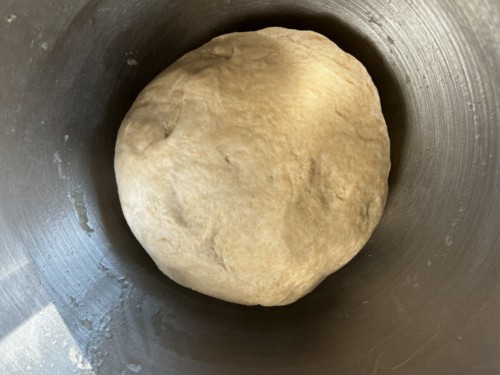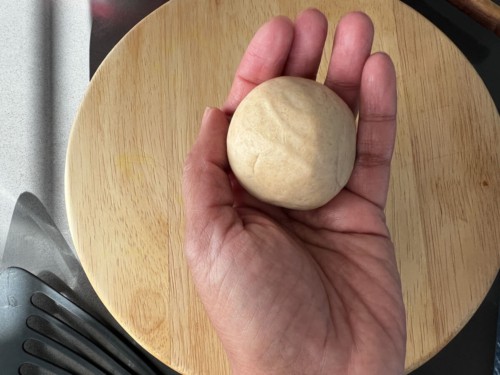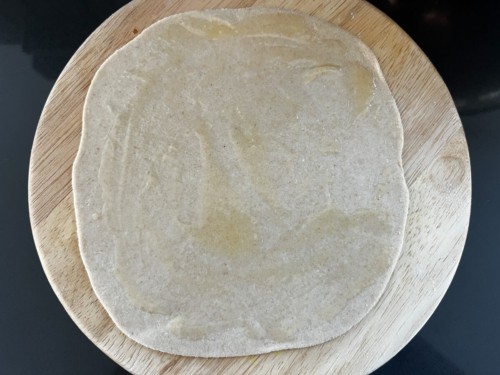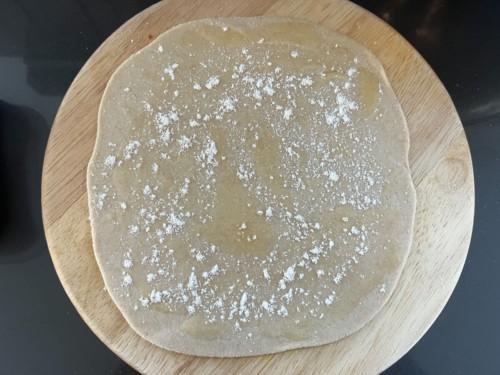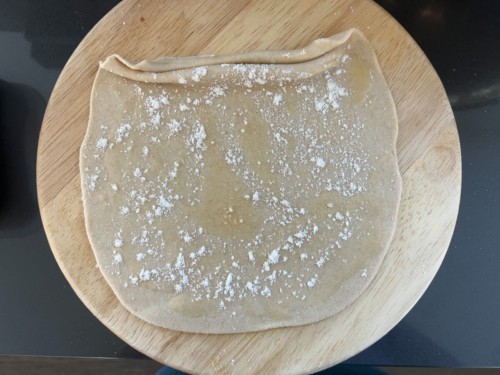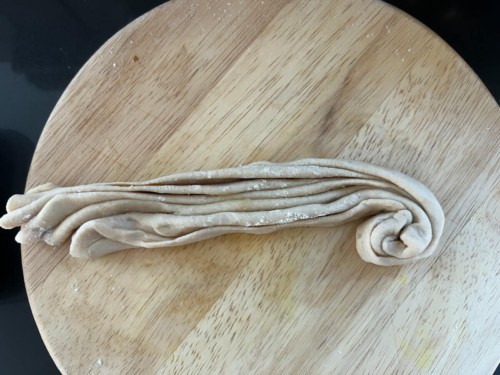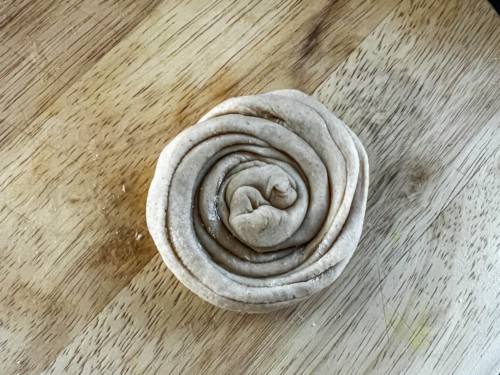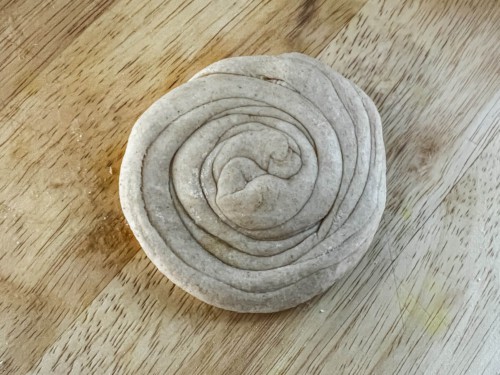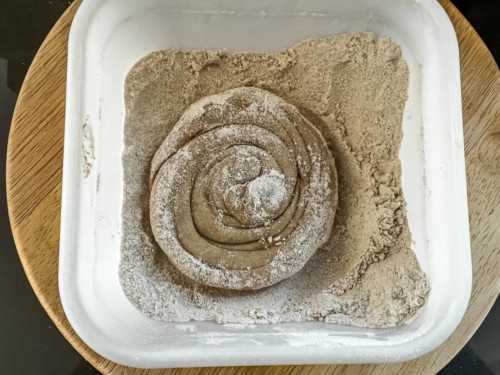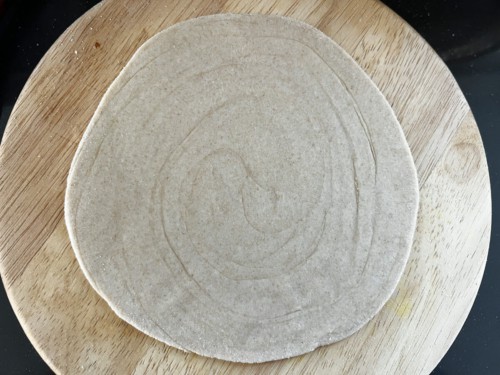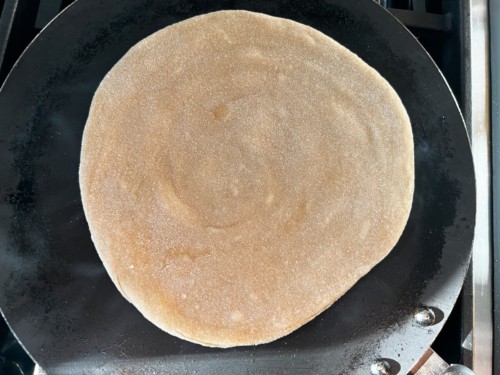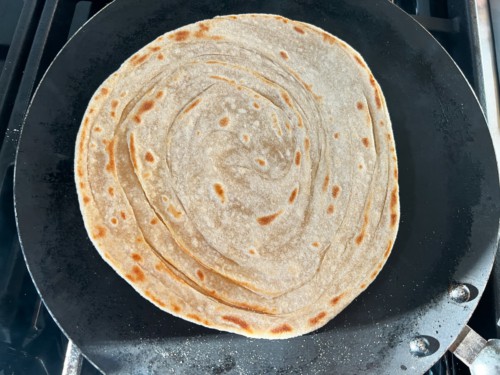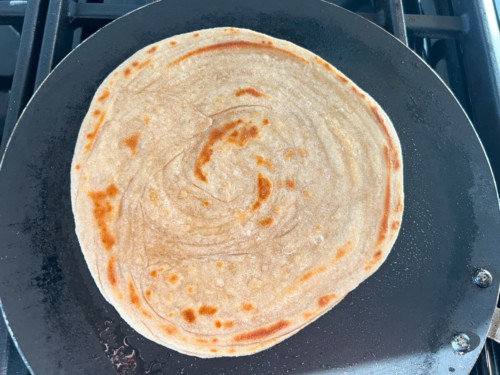Lachha paratha (Layered Indian Flatbread)
Note: This post contains affiliate links. As an Amazon Associate I earn from qualifying purchases.
Master making lachha or lachedar paratha with this easy recipe. Flaky and crisp, this layered paratha comes together with five simple ingredients. Perfect for breakfast, a snack, or served alongside dals, curries, and more, this buttery Indian flatbread satisfies everyone!
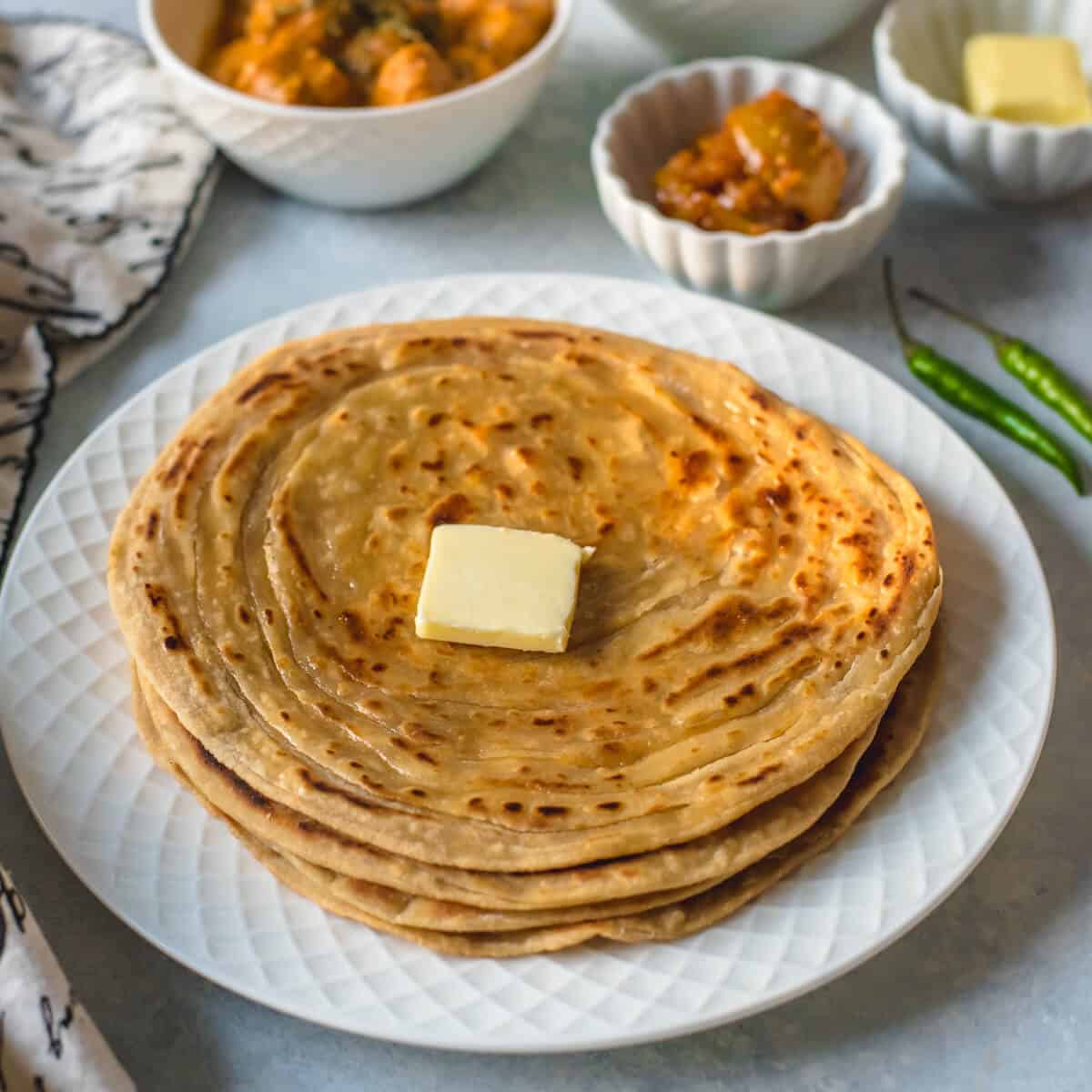
Paratha 101
Paratha is one of the most common flatbreads that originated in the Punjab region of northern India.
Nothing says comfort food quite like a warm paratha. Often served as breakfast, this filling unleavened flatbread made with whole wheat flour pairs well with just about everything.
If you have never made paratha before, they are similar to roti with a few key differences. While they both consist of roughly the same ingredients, paratha is rolled and folded to create layers which also results in a crispy, flaky flatbread with golden brown spots.
There are two main types of paratha, layered and stuffed. Layered parathas have spices or fillings added while making the dough, whereas stuffed parathas such as aloo paratha or paneer paratha have stuffings filled in during the rolling process.
Looking for a recipe for plain paratha? Learn how to make it 3 ways – round, triangle, and square-shaped.
What is lachha paratha?
Lachha paratha, pronounced laa·chuh pr·aa·thuh, also may be called lachedar paratha or paratwala paratha. Some other spellings of lacha include laccha, lacha, or laccha, but they all refer to the same whole wheat, multi-layered, unleavened bread.
This variation of paratha gets its name from the unique layers or rings you can see in the rolled-out dough. To achieve these distinctive rings, the soft dough is rolled flat, like a roti, then coated in ghee or oil and pleated like a fan. The pleated dough is then rolled into a coil, flattened, and rolled again into a flat disk before being lightly fried.
Reasons to love this recipe
Fresh and flaky, there are so many reasons to love this buttery flatbread. Some of the main reasons we love this laccha paratha recipe would be because it is
- Vegan-friendly – With a simple swap from ghee to avocado oil, you can easily make this layered and flaky paratha a vegan flatbread.
- Freezer friendly – Both the dough and the cooked lachha paratha store well in the freezer for future meals.
- Versatile – Spice this simple paratha dough with a masala blend or season with ajwain seeds for a different flavor, depending upon how you serve them.
- Needs only a few ingredients – Made with 5 pantry-staple ingredients, this simple laccha paratha quickly comes together any day of the week.
Here’s what you need to make lachha parathas
Ingredients
- Whole wheat flour– Used both in the dough for the paratha and to help roll out the dough later.
- Salt– optional, but really enhances the flavor of this paratha.
- Oil– Avocado or vegetable oil work best.
- Water– At room temperature.
- Melted ghee – Substitute with avocado oil to make this paratha vegan.
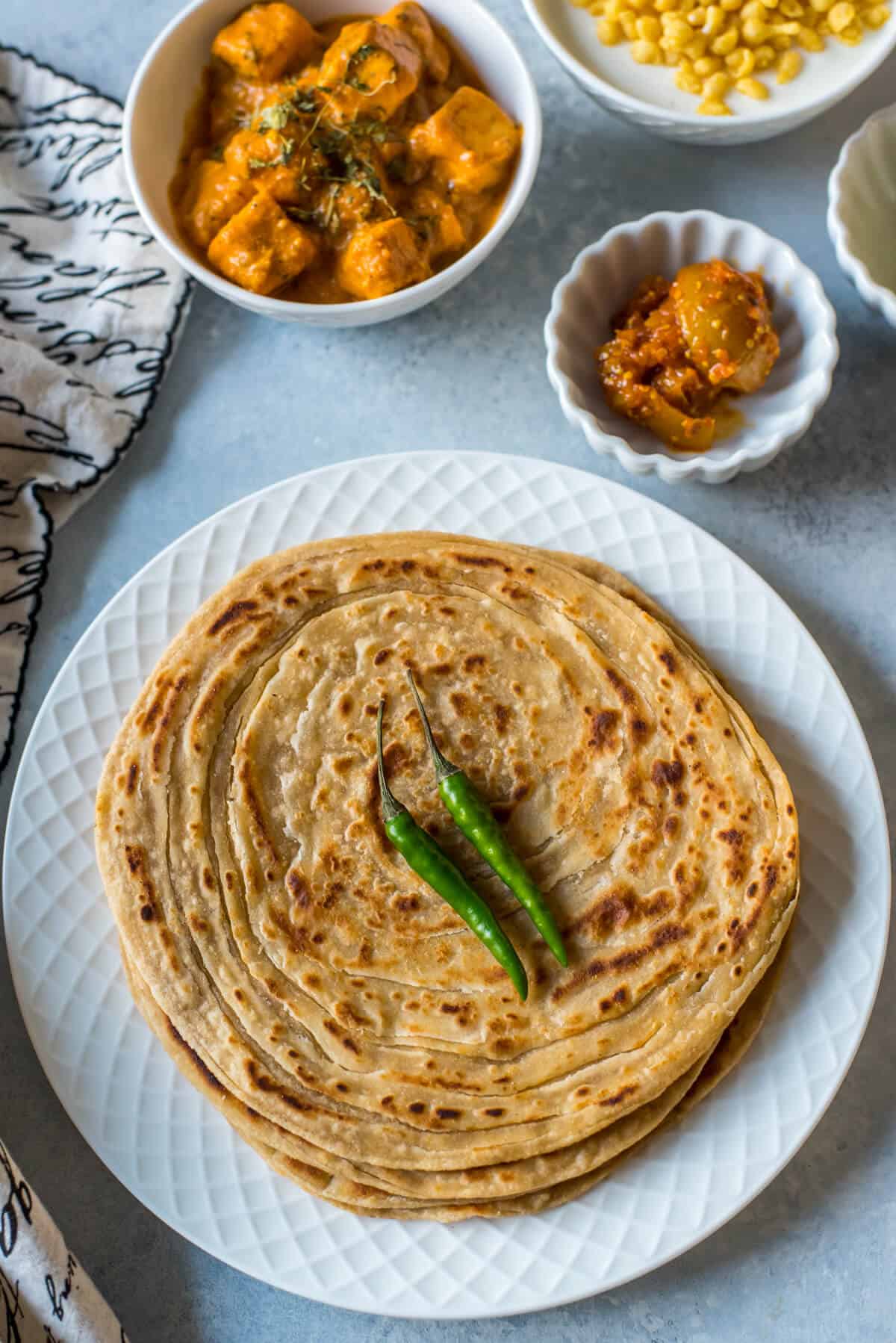
Tools
You’ll need the following equipment to make parathas
- Large mixing bowl or stand mixer / food processor
- Rolling board – Metal/ marble / wood base with a rolling pin (or Chakla Belan in Hindi)
- Tava / Griddle
- Spatula / Turner
- Paper towel
TIPS
- Knead the dough until it is smooth, soft, and pliable.
- To fix hard dough, Sprinkle a spoonful of water and knead. Add more water as needed until the dough is neither hard nor sticky.
- Sticky dough? Sprinkle a spoonful of dough and knead. Add more flour as needed until the dough is not sticky.
- Rest the dough to allow time for the gluten to form. This makes it easier to roll out the dough and yields softer parathas.
- Make sure to dust off the dry flour from the parathas before frying, or it dries up and turns hard.
- Before storing it in an air-tight container or while packing it for lunch, let the paratha cool down for 5-6 minutes to prevent it from being soggy.
Note: Don’t forget to turn your exhaust fan on when making parathas, or else your smoke alarm may go off.
Variations to try
- Spice it up – Make masala paratha by adding 1/2 teaspoon of these spice powders – chili powder, coriander, and cumin powder while making the dough.
- Ajwain paratha – Ajwain or carom seeds aid digestion. Add 1/2 tablespoon of ajwain (carom) seeds for every cup of whole wheat flour while making the dough and make the paratha as usual.
- For a vegan version, use oil instead of ghee.
How to prep ahead
The best way to prepare this lachha paratha in advance is to make the dough ahead of time. Follow the steps for making the dough as listed in the instructions, and when it is time to allow the dough to rest, store it in either the refrigerator or the freezer.
- Refrigerated dough stays keeps in an air-tight container for up to 3 days.
- The frozen dough keeps for a month.
Bring the lachha paratha dough to room temperature before rolling out the parathas.
Storage tips
- Refrigerator – When cooled and placed in an air-tight container, the rolled paratha lasts for 4-5 days.
- Freezer – Parathas keep for 2-3 months when frozen. I recommend separating them with parchment paper when freezing, or they’ll stick together.
- Reheat – For refrigerated parathas, reheat in a microwave (15-20 seconds) or reheat in a tava / skillet kept over medium heat. If parathas are frozen, use a tava/skillet to reheat for best results.
Serve it with
This flaky and savory flatbread can be paired with curries to make a meal or savored for breakfast with butter on top with a side of pickle. Serve laccha paratha hot with some of your favorite Indian curries, such as

Frequently asked questions
Laccha paratha is pronounced laa·chuh pr·aa·thuh.
Paratha is the general term for an unleavened flatbread made with whole wheat. Laccha paratha refers to a specific type of paratha made from layering the dough during the rolling process.
Laccha paratha comes from the Indian state of Punjab.
The homemade version is made from whole wheat flour, but sometimes the store-bought frozen ones or the restaurant ones can be a mix of whole wheat flour or all-purpose flour.
Malabar paratha is the South Indian variation of the laccha paratha, originating in the Northern part of India. Malabar parotta, or Kerala parotta, is made from maida (all-purpose flour), thus making it softer, whereas lacha paratha is traditionally made from whole wheat flour or atta.
Other popular Indian flatbread recipes to try
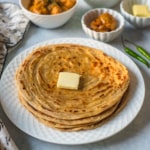
Lacha Paratha recipe
Equipment
Ingredients
- 3 cups whole wheat flour
- ½ teaspoon salt optional
- 2 tablespoons oil (avocado or vegetable) + 1/4th teaspoon oil
- 1.5 cups water or as needed, at room temperature
For rolling out
- ¼ cup whole wheat flour for rolling
- ½ cup melted ghee (as needed)
Instructions
Making the dough
- Combine wheat flour, salt, oil with 1 cup of water in a large bowl and start kneading. Add water in small increments and continue to knead till the dough comes together as a ball.

- Add 1/4th teaspoon oil to the dough and knead till the oil is absorbed.
- If the dough is sticky, sprinkle approximately 1/4 teaspoon wheat flour (or more if needed) on the dough and knead again to form a dough that is not sticky. The dough should be supple and soft.
- Cover the dough and set aside for 15-20 minutes.

Making parathas
- Pull a small piece approximately the size of a golf ball from the dough. Place the piece between the palms of your hands and shape them into a ball. Flatten the ball and cover both sides with flour.

- Roll out the flattened ball into a circular shape (approximately 6 inches in diameter).

Rolling parathas
- Smear the surface of the rolled-out dough with ghee.

- Sprinkle some flour evenly then begin to pleat the paratha.

- Pleat the rolled out paratha into a fan.

- Roll the fan inward into a coil.

- Once you reach the end, pull the edge and tuck it under the coil.

- Flatten the coil until it looks like a disc.

- Dip the flattened disc in the flour.

- Roll out the flattened ball evenly into a circular shape (approximately 7-8 inches in diameter). Dust more flour as needed to help with the rolling.

Cooking paratha
- Heat a pan / tawa over medium-high heat.
- Dust off excess flour from the paratha by placing it on your palm of one hand and then flip it on the palm of your other hand. Repeat this process 3-4 times.
- Place the paratha in the hot pan. Cook the paratha until small bumps form on the surface (approximately 1-2 minutes).

- Flip the paratha onto the other side. Cook for 30-40 seconds or so until you see brown spots. Smear it with ghee and flip it.

- Cook for 20-30 seconds, then brush the side facing up with ghee. Use a spatula to press down the paratha so that it evenly cooks.
- Flip it and cook it for another 15-20 seconds while pressing the paratha down with the spatula.

- Transfer the paratha to a plate lined with paper towels. Repeat this process for the rest of the dough.
- Serve it hot with dal, vegetable or chicken curry.
Notes
- To fasten up the process, roll out the next paratha as one cooks in the pan.
- Make sure to dust off the excess flour from the paratha before you cook it. This prevents the paratha from getting hard.
- Before storing it in an air-tight container, let the paratha cool down a bit so as not to make it soggy.
Disclaimer: Approximate nutritional information is provided as a courtesy and can vary depending on the exact ingredients/brands used. If you have health issues, please work with a registered dietician or nutritionist.

